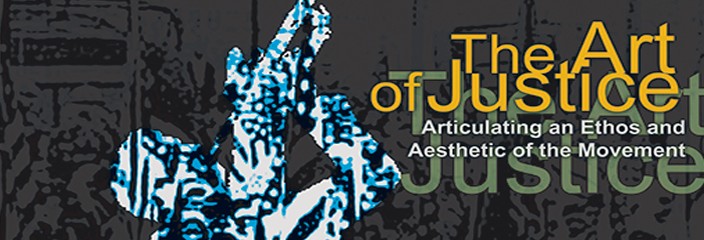The Art of Justice: Articulating an Ethos and Aesthetic of the Movement

A One-Day Conference
“We knew we heard Monk and Mongo differently; Trane’s tenor seized our spirit, shook our consciousness while Miles blue thru a cold trumpet that cooled the asphyxiating heat of our collective hell in America… Ours was the first American aesthetic revolution.”
— Felipe Luciano 2015
It is essential to understand historically the centrality and necessity of art in the quest for social and political justice. Especially In the age of Ferguson, it is important to remember that the “Black Lives Matter” movement is in the tradition of ongoing historical struggles. Currently cell phone cameras have provided the evidence to stimulate a new political consciousness through its ability to document social and political conditions in real time. Hip-Hop culture, with its’ fusion of ‘the beat’ and social commentary, has provided the musical context for contemporary social activism. This marriage of aesthetics and politics has a long history in the Americas, especially in the 60’s, 70’s and 80’s Native, Black, Latino, Asian and Progressive Euro-American arts movements, which were inspired and influenced by the Civil/Human Rights Movement in the United States, and by the freedom or anti-colonial movements in Africa, Asia and the Americas.
With a particular focus on the Black and Nuyorican Arts Movements, The Art of Justice: Articulating an Ethos and Aesthetic of the Movement conference will present the ideas, and aesthetics of those earlier movements honoring and guided by the first hand voices documenting their actual experiences. There will be an emphasis on group discussion and audience participation.
The essential themes to be discussed are: the universality of the struggle for justice and the art that served it; the continuity of the struggle with others like the Negritude Movement, the Harlem Renaissance, Marcus Garvey’s and the UNIA, and the Hon. Elijah Muhammad and the Nation of Islam; the celebration of historic activist, including Marcus Garvey, Carlos Cooks, Elombe Brath, Amiri Baraka, Mario Bauzá, Frank ‘Machito’ Grillo, Tito Puente, Asadata Dafora, Pearl Primus, Katherine Dunham, Diego Rivera, Baba Osergiman, Nana Yao Opare Dinizulu, Babatunje Olatunji, Syvilla Fort, Max Roach, Abbey Lincoln, Sun Ra, Nina Simone, Fred Ho, Pete Seeger and others; the reassessment of current movements such as Nuyorican Poets Cafe, La Raza, American Indian Movement, the Asian Arts Movement and the Guerrilla Girls.
The conference is being produced by the Caribbean Cultural Center-African Diaspora Institute, the Institute of African American Affairs and the Department of Art and Public Policy, both of New York University. The conference will consist of a series of a total of three gatherings. The first will take place at NYU on Saturday, November 7, 2015. It will be composed of a full day gathering with a keynote address followed by three roundtable panels. There will be a focus on the art created by artists actively involved the in the movements. The panels are constructed to encourage open discussions as opposed to a lecture format, and to present a selection of the visual arts produced by the participants. Those who were personally active in the political arts movements will facilitate the discussions. The events of the day will conclude with an evening solo piano concert by Randy Weston.